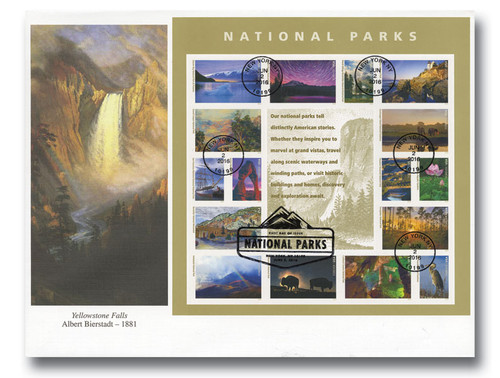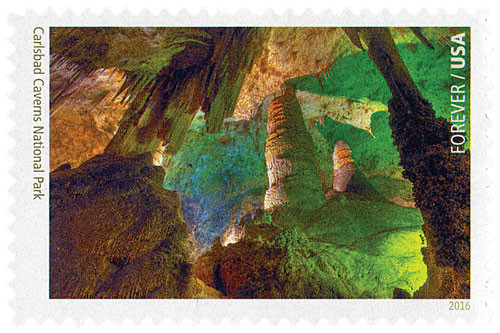
# 5080a - 2016 First-Class Forever Stamp - National Parks Centennial: Glacier Bay National Park and Preserve
US #5080a
2016 Glacier Bay National Park and Preserve – National Parks
- Honors Glacier Bay National Park and Preserve
- One of 16 stamps celebrating the 100th anniversary of the National Park Service
Stamp Category: Commemorative
Set: National Parks
Value: 47¢ First Class Mail Rate (Forever)
First Day of Issue: June 2, 2016
First Day City: New York, New York
Quantity Issued: 100,000,000
Printed by: Banknote Corporation of America
Printing Method: Offset, Microprint
Format: Panes of 16
Tagging: Phosphor tagged paper, block
Why the stamp was issued: To celebrate the beauty and natural wonders of Glacier Bay National Park and Preserve.
About the stamp design: Includes 16 designs, each picturing existing art or photographs of national parks or plants, animals, artwork, objects, or structures in national parks. The margins of each stamp includes the name of the location. coincide with the 100th anniversary of the National Park Service.
First Day City: The First Day of Issue Ceremony was held at the Javits Center in New York City as part of the World Stamp Show NY 2016.
About the National Parks set: Includes 16 stamp designs, each picturing existing art or photographs of national parks or plants, animals, artwork, objects, or structures in national parks. The margins of each stamp include the name of the location. Issued to coincide with the 100th anniversary of the National Park Service. The central image on the sheet of 16 pictures the 1¢ Yosemite postage stamp issued in 1934 along with the text “Our national parks tell distinctly American stories. Whether they inspire you to marvel at grand vistas, travel along scenic waterways and winding paths, or visit historic buildings and homes, discovery and exploration await.”
History the stamp represents: In 1879, naturalist and “father” of Yosemite National Park John Muir visited Glacier Bay, Alaska. He wanted to study an active glacier to help him understand the glaciated landscape in Yosemite Valley. His research brought attention to the Alaskan coast, and soon scientists and tourists were visiting the bay to see the famous Muir Glacier.
Interest in Glacier Bay waned after a 1899 earthquake sent the Muir Glacier crashing into the water. But ecologist William Skinner Cooper was not deterred. Starting in 1916, he used the retreating glacier to study plant succession on the newly exposed ground – and he recognized the need to protect it.
By 1925, Cooper and the Ecological Society of America had promoted and achieved national monument status for a small area of the bay. Over time, proposals, studies, and grants added more land to the protected area. Glacier Bay National Monument was soon larger than any national park in the US. Finally, in 1980, President Carter signed a law converting almost 3.3 million acres to Glacier Bay National Park, with 57,000 acres designated as a preserve.
More than half a million people visit the glacier every year. And scientists continue to take advantage of the changing landscape in what they now refer to as a “living laboratory.”
US #5080a
2016 Glacier Bay National Park and Preserve – National Parks
- Honors Glacier Bay National Park and Preserve
- One of 16 stamps celebrating the 100th anniversary of the National Park Service
Stamp Category: Commemorative
Set: National Parks
Value: 47¢ First Class Mail Rate (Forever)
First Day of Issue: June 2, 2016
First Day City: New York, New York
Quantity Issued: 100,000,000
Printed by: Banknote Corporation of America
Printing Method: Offset, Microprint
Format: Panes of 16
Tagging: Phosphor tagged paper, block
Why the stamp was issued: To celebrate the beauty and natural wonders of Glacier Bay National Park and Preserve.
About the stamp design: Includes 16 designs, each picturing existing art or photographs of national parks or plants, animals, artwork, objects, or structures in national parks. The margins of each stamp includes the name of the location. coincide with the 100th anniversary of the National Park Service.
First Day City: The First Day of Issue Ceremony was held at the Javits Center in New York City as part of the World Stamp Show NY 2016.
About the National Parks set: Includes 16 stamp designs, each picturing existing art or photographs of national parks or plants, animals, artwork, objects, or structures in national parks. The margins of each stamp include the name of the location. Issued to coincide with the 100th anniversary of the National Park Service. The central image on the sheet of 16 pictures the 1¢ Yosemite postage stamp issued in 1934 along with the text “Our national parks tell distinctly American stories. Whether they inspire you to marvel at grand vistas, travel along scenic waterways and winding paths, or visit historic buildings and homes, discovery and exploration await.”
History the stamp represents: In 1879, naturalist and “father” of Yosemite National Park John Muir visited Glacier Bay, Alaska. He wanted to study an active glacier to help him understand the glaciated landscape in Yosemite Valley. His research brought attention to the Alaskan coast, and soon scientists and tourists were visiting the bay to see the famous Muir Glacier.
Interest in Glacier Bay waned after a 1899 earthquake sent the Muir Glacier crashing into the water. But ecologist William Skinner Cooper was not deterred. Starting in 1916, he used the retreating glacier to study plant succession on the newly exposed ground – and he recognized the need to protect it.
By 1925, Cooper and the Ecological Society of America had promoted and achieved national monument status for a small area of the bay. Over time, proposals, studies, and grants added more land to the protected area. Glacier Bay National Monument was soon larger than any national park in the US. Finally, in 1980, President Carter signed a law converting almost 3.3 million acres to Glacier Bay National Park, with 57,000 acres designated as a preserve.
More than half a million people visit the glacier every year. And scientists continue to take advantage of the changing landscape in what they now refer to as a “living laboratory.”








